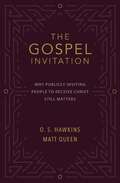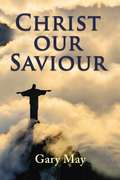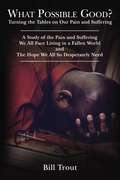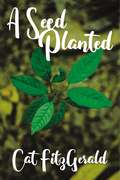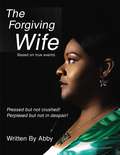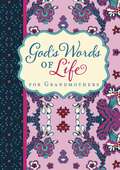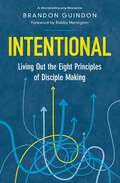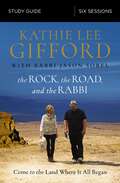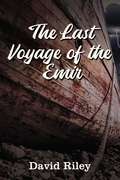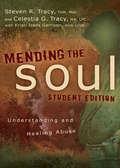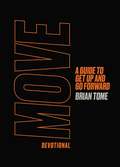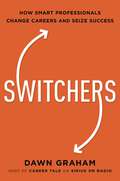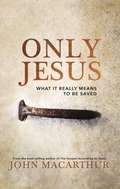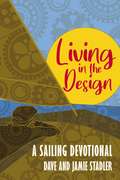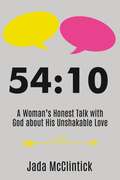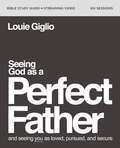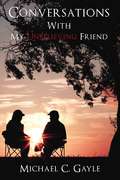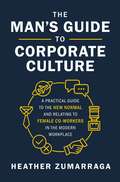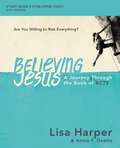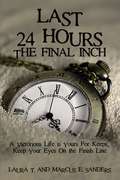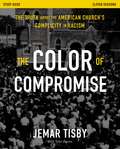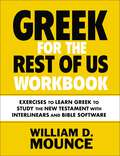- Table View
- List View
The Gospel Invitation: Why Publicly Inviting People to Receive Christ Still Matters
by O. S. Hawkins Matt Queen2024 OUTREACH RESOURCE OF THE YEAR (EVANGELISM)An essential guide in the art and instruction of issuing Christ's invitation to the lost.Historic denominations are dying. Church memberships and baptisms plummet with every passing year. Pastors and church leaders are concerned about their churches plateauing. Why? One of the major reasons is because congregations aren't being publicly called to faith in Christ. A growing number of evangelical pastors have opted for non-confrontational approaches to calling people to faith in Jesus. Some seminaries have removed evangelism classes from their curriculum and pastors aren't being taught how to give an effective, God honoring public invitation, void of manipulation.Authors O.S. Hawkins and Matt Queen are asking church leaders to reconsider and rediscover the effectiveness of asking people to publicly decide to follow Christ.O.S. Hawkins is a respected pastor who has led thousands to faith in Christ in both church and public settings. Matt Queen is a trusted and gifted professor of evangelism who has consulted multitudes of pastors in personal and congregational evangelism. Together, they wrote The Gospel Invitation to assist others in successfully issuing a public appeal to receive Christ.The Gospel Invitation covers:A brief history of public gospel invitationsThe biblical justification for gospel invitationsPractical and proven instructions for incorporating invitations into sermonsBest practicesThe Gospel Invitation will equip pastors, seminary students, and anyone who evangelizes with the confidence to share the gospel and help more people come to Christ.
The Real Estate Agent's Guide to FSBOs: Make Big Money Prospecting for Sale By Owner Properties
by John MALOOFThis invaluable resource provides you with tools and techniques to make big money by prospecting For-Sale-By-Owner properties. According to the National Association of Realtors, 86% of new real estate agents don&’t make it past their first year. The majority give up due to frustration and the overwhelming start-up costs involved in the industry. However, there is an untapped resource that will help agents take their careers to new heights?the For-Sale-By-Owner (FSBO) listing.Author John Maloof has built a stellar career by farming FSBOs. He made six figures his first year as a real estate agent using his prospecting plan. Now, in The Real Estate Agent's Guide to FSBOs, he shows other agents how they can do the same. Using these proven techniques, agents will learn how to:find FSBOsapproach a prospectmake a listing presentation that will convince even the most reluctant homeownerhandle rejectionsformulate a marketing planservice listingsbuild a referral basestage open housesclose the sale Complete with Internet resources and a sample resume and log sheet, The Real Estate Agent's Guide is the one book that will show new agents and experienced realtors alike how to make more money than they ever thought possible.
Imaginative Prayer for Youth Ministry: A Guide to Transforming Your Students' Spiritual Lives into Journey, Adventure, and Encounter
by Jeannie Oestreicher Larry WarnerHow often have you struggled to help your students really grasp God’s love? How often have you been frustrated by their Sunday school answers when you try to draw them into the depths of God’s story? You’re not alone. Many students (and even youth workers brave enough to admit it) are experiencing emptiness, lack of passion, and a growing inability to hear from God.But there is hope. Just use your imagination…God created our imaginations. Why not harness them to encounter our creative God in brand new ways? Try it right now: Picture yourself in a boat with Jesus as the seas grow rough, as the water crashes over the bow. Notice what’s going on…notice your emotions at this critical moment. What is your sense of Jesus’ presence in the midst of the storm?The latter is just one example of the many guided exercises within the pages of Imaginative Prayer for Youth Ministry. You’ll find tools that can help you use imaginative prayer as a means of experiencing the God who is continually reaching out to us. Invite your students to open their imaginations (and their five senses) to God’s spirit and allow God to move and speak directly to them through the 50 imaginative prayer exercises inside. They come complete with instructions, environment suggestions, and optional debrief questions—there’s even a topical/Scripture reference index so you can find just the right exercises to suit your needs. If you want to introduce your students to the God who loves them (in a way that allows them to truly experience that love), imaginative prayer is an effective means to do so—you and your students will never be the same.
What Possible Good?: Turning the Tables on Our Pain and Suffering A Study of the Pain and Suffering We All Face Living in a Fallen World and The Hope We All So Desperately Need
by Bill TroutIn the midst of our own intense storms of life, we desperately search for an anchor of hope. This book by author Bill Trout takes us on a journey towards gaining a better understanding of our pain and suffering. We will find that God alone is the one true steadfast anchor that we seek. Believers in Jesus are firmly secured to God as our anchor by a heavenly chain of very strong links. One of the most vital links is found in the answer to the following question: &‘What possible good could come from our suffering?&’ There is great news! God can and does turn bad things into good things for us. To see him at work in our lives we need to ask God to open our spiritual eyes. To improve our vision of the Master Potter at work, we will look through a number of different spiritual lenses. Each lens will permit us to see a different Biblical perspective of viewing our pain and suffering. Not only will we see a broad range of the possible causes and sources of our trials, but also we will discover additional links in the chain of hope, which may have eluded us thus far. Though we have a natural tendency to blame God for our pain and suffering, we will learn that the devil is the primary cause for most of the trials we face. But more great news! As we grow in our faith and trust in God, we realize that he is an expert at &‘turning the tables&’ on all of the devil&’s deceptive schemes to tempt, torture and destroy us. God clearly &“works for the good of the those who love him, who are called according to his purpose.&” (Romans 8:28) He is the master of turning potential defeat into decisive victory! If we hold tight to him as our anchor, we can safely and securely ride out all of the storms of life until we reach that promised eternal heavenly shore!
A Seed Planted
by Cat FitzGeraldJulia (JuJu) Ready begins life in a hard place. Born to an unwed teenage mother in 1948, she is eventually given up for adoption at the age of eleven months, handed over to a couple who probably should never have had children. As she grows, the rejection by her birth mother, coupled with verbal abuse and neglect from her adopted parents, leads her to resentment that grows deeper and deeper into a series of bad choices.JuJu&’s saving grace and refuge has always been her Grandma Jean who lives across the highway on the family farm. Despite her grandmother&’s unconditional love and fervent prayers, JuJu grows distant following a tragic event that hardens her heart. She withdraws from her friends, intent on graduating high school early and leaving the small town of Serendipity, Georgia far behind. JuJu&’s good intentions to stay in touch with Grandma Jean are overcome by the freedom she has at college, and when tragedy occurs, she finds herself without an anchor in the adult world she is about to enter.Armed with her diploma and plans for continued education, JuJu pushes her way into the field of higher learning, capturing the attention of her superior, a handsome fellow with a Ph.D., and a bucketful of charm and sophistication. Adam represents everything JuJu, now going by Julia, has ever wanted in a man, mature and smart, nothing like the boys from college or even graduate school. His flattery feeds a deep need in Julia, and it isn&’t long before the relationship moves well beyond that of boss and employee. However, the past will rear its ugly head in the form of repeated loss, and Julia is left alone to pick up the pieces.Forced to return to her rural hometown, Julia is hurt and ashamed, but mostly angry. Angry at how life has treated her. Angry at the God who rejected her by never answering her prayers. And extremely angry at the young man who is now running the family farm. Determined to get rid of him so she can sell the property, Julia is surprised to discover she has met her match when it comes to stubbornness. She&’s doubly furious to learn of his devoted faith to God, which she finds beyond irritating.Will Julia be influenced by Marley&’s witness, or will she wear him down with her antagonistic approach to almost everything?Rejection, rebellion, remorse, repentance, and resurrection come full circle in this story of a rocky path becoming good soil.
The Forgiving Wife: Pressed but not crushed! Perplexed but not in despair! Based on true events
by AbbyHow did the book, The Forgiving Wife come up? It was the year 2007 when the Holy Spirit prompt me to write about my story. At first, I was reluctant and pulled back, but the spirit of God kept pressing upon me. I finally decided to start jutting information here and there. As I started to gather more and more memories of my early marriage each day. I realized that I didn&’t have a name for the book. I then consulted God about giving me a name for the book. Within ten minutes of me asking, the Holy Spirit spoke quite clearly and said calmly, The Forgiving Wife. Not putting up a fight with what I heard and felt, I continued writing. As I gained confidence in writing my book, my marriage once again started to spiral downhill in 2011. I then started to doubt my book and asked what sense was it to continue? There was no way I could finish my book. How would I end it? Not sure of which way to steer my writing anymore, I was forced to stop writing. After taking another blow to my marriage in October of 2015.Two years later I finally realized that my battling marriage was far bigger than my husband and me. This was far beyond our intellect. I realized that we were not walking this road for ourselves but, for someone else. July 30th, 2017, I began to consolidate all of the writing pieces into chapters. After receiving approval from my husband to write about our personal, behind the scenes relationship. I then had a clearer understanding as to why I was writing this book in the first place. It was to help broken and hurting women out there. I wanted to let the world know that Jesus is still in the business of restoring, healing, changing and saving lives! I&’m not asking you if Jesus can do it, I&’m telling you that he can! I urge readers that if you don&’t have Jesus as the head of your marriage and home, get him because you will need him! Some battles you win and some you lose. Whatever the case may be, don&’t allow your marital issues cause you to become so disoriented that you want nothing to do with life anymore. Neither let them allow you to lose your integrity, your dignity, nor your identity! At the end of the day, both spouses must want the same thing. This book is intended to help both men and women. I explained in this book that fighting for your marriage is not an easy fight. As a matter of fact, in the book shows how difficult and discouraging it got for me at times. I talked about how I was at my lowest point. Where I felt like my breath was literally being snuffed away from me, but God! It talks about how I was so confused at times; I almost lost my mind. I do not suggest you stay in a marriage if the situation is life threatening. This book does not talk about having a perfect marriage. As a matter of fact, my book shows that my marriage is still far from perfect, we must learn to accept imperfections as well. You won&’t regret buying this book. The content is intriguing, the events are interesting and engaging. And the message is authentic!
God's Words of Life for Grandmothers: Encouraging Devotions and Bible Verses for Every Grandma (A 42-Day Devotional) (God's Words of Life)
by ZondervanFind inspiration and encouragement from God&’s Word for navigating the joys and challenges of being a grandmother.This beautiful, topically arranged devotional will encourage you whether you are a new grandma or have years of grandparenting experience. With hundreds of verses on topics such as hope, family, and God's faithfulness, God's Words of Life for Grandmothers reminds you of God's presence as you delight in loving your grandchildren wellWith hundreds of Bible verses covering more than 40 topics, God's Words of Life for Grandmothers will provide you with encouragement and wisdom directly from God&’s Word. Each devotional entry features several written-out Bible verses that speak to a specific topic along with devotional insights from Charles Swindoll, David Jeremiah, J. Oswald Sanders, Kay Arthur, Max Lucado, Billy Graham, and others. God's Words of Life for Grandmothers covers over 40 topics important to grandparents, such as:FamilyLegacyWisdomHealthGod&’s LoveAnd many more This beautifully designed devotional makes a wonderful gift for grandmothers for Mother's Day, birthdays, Christmas, Valentine's Day, or any special occasion.Whether you&’re looking for assurance during tough times or mindful reflection in seasons of gratitude, God's Words of Life for Grandmothers will strengthen your heart and mind as you build a legacy for the next generation.
Intentional: Living Out the Eight Principles of Disciple Making
by Brandon GuindonRediscover the intentional disciple making methods of Jesus Christ.Today, churches and their leaders relentlessly pursue innovation of the next new idea that will somehow capture the attention of the spiritually lost, yet very few Christians know how to walk out a day-to-day lifestyle of intentional disciple making.Drawing from decades of experience making disciples, pastor Brandon Guindon will show you how Jesus' call to "Go and Make Disciples" can become more than just a vague church slogan when we relearn the discipleship methods that Jesus modeled for us.Intentional introduces eight principles of disciple making, exposing their gospel roots and practical nature—principles such as:Listening with the genuine intent to understand different voices and experiences.Looking for and developing the potential in others.Knowing when to firmly speak the truth and when to allow yourself to be interrupted.Living a lifestyle of discipleship yourself. Jesus Christ intentionally discipled twelve people every day for three and a half years and then commanded us to go and make disciples as well. And he empowered us by sending us the indwelling Holy Spirit to guide us. The early church thrived and expanded by imitating the intentional relational methods Jesus modeled, yet somewhere along the way we lost sight of the simple truth that Jesus' methods of disciple making are as holy as his message.It's time relearn those methods, examine the obstacles in our lives that prevent us from imitating the ancient ways of Christ, and approach all our relationships differently—making disciples in Jesus' name and growing spiritually in the process.
The Rock, the Road, and the Rabbi Bible Study Guide: Come to the Land Where It All Began
by Kathie Lee GiffordKathie Lee Gifford always believed the Bible held the answers to every question a person could ask. Her problem was: how could she be sure of what the Bible was really saying when we are so separated from the ancient Jewish culture in which it was written? As a lifelong student of Scripture, Kathie Lee Gifford has always desired a deeper understanding of God&’s Word and a deeper knowledge of God Himself. But it wasn&’t until she began studying the biblical texts in their original Hebrew and Greek—along with actually hiking the ancient paths of Israel—that she found the fulfillment of those desires. In this six-session video study (DVD/video streaming sold separately), Kathie Lee invites you to join her as she visits sites in Israel that have impacted her life. As she shares her story, Rabbi Jason Sobel, a messianic Jewish rabbi who was trained in the ancient rabbinical way, provides fascinating background details into the language, culture and heritage that make the story of the New Testament come alive. Kathie Lee and Rabbi Sobel will take you and your group beyond the typical "Sunday school" teaching to examine the original texts of the Bible. Now you can walk with Kathie on a journey through the spiritual foundations of her faith: The Rock (Jesus Christ): Hear directly from Kathie about her life-changing and ever-deepening connection with Jesus, the Lover of her soul. The Road (Israel): Explore dozens of ancient landmarks and historical sites from Israel, the promised land of God&’s covenant. The Rabbi (God&’s Word): Go beyond a Sunday-school approach to the Bible by digging into the original languages and deeper meanings of the Holy Scriptures. Come! Explore the land of Israel and mine the treasures of God's Word. There is so much more! Sessions include: Bethlehem: Where It All Began Nazareth: The Early Years Capernaum: Ministry Headquarters Galilee: Ministry Grounds Mount of Olives: The Triumphal Entry Jerusalem: Crucifixion and Resurrection Designed for use with The Rock, the Road, and the Rabbi Video Study (9780310095033), sold separately.
The Last Voyage of the Emir
by David RileyTemeros is a young man alone in the world and seeking his purpose in life. His father, Demetrius the silversmith of Ephesus, hated Paul and his rage led to tragedy leaving Temeros homeless, orphaned and scarred. Eventually, Temeros finds himself in the port of Myra where he joins the crew of an Egyptian grain ship, called The Emir, bound for Rome. During this voyage, he meets Paul and realizes he is not the monster his father believed him to be. He comes to faith in Christ and becomes Luke&’s apprentice in treating the medical needs of the passengers and crew.It is not all smooth sailing, however. Someone sneaks aboard intent on revenge against Paul, but within a few hours the ship is caught in a terrible storm that threatens the lives of everyone on board. Eventually, The Emir runs aground on the island of Malta. When Temeros discovers the identity of the attacker, he and his newfound friends must rush to save Paul.Come along on The Last Voyage of The Emir as we explore what happens in the storm and the ensuing shipwreck.
Mending the Soul Student Edition: Understanding and Healing Abuse
by Steven R. Tracy Celestia G TracyFor teenagers who have experienced any kind of abuse or abandonment, it can often feel like hope is lost and they’re doomed to stay stuck in unhealthy habits and patterns. This teenage edition of Mending the Soul was written to show teens that by following a path of restoration and allowing God’s grace to touch their heart’s deepest wounds, they will find hope and healing as they work through their pain. It will help them navigate the emotional trauma of abuse and abandonment, as well as recognize signs of unhealthy families and dating relationships. Armed with a better understanding of their past and how the effects of abuse can lead to risky behaviors, shame, trauma and isolation—teens will be encouraged to face their brokenness, to heal and forgive and to look toward their hope-filled future.A practical resource for teens, Mending the Soul, Student Edition also offers insight into the struggles parents and ministry leaders face when working with teenage victims of abuse.
Move Devotional: A Guide for Men to Get Up and Go Forward
by Brian TomePropel your life forward with this devotional just for men as you dig into the Bible, strengthen your prayer life, and take practical challenges designed to get you off your spiritual couch and into a more fulfilling life.Move Devotional by pastor, husband, and dad Brian Tome is perfect for any man who is tired of the status quo and wants to live a life of greater significance and relevance. This inspiring, accessible book includes:Practical strategies for the everyday man to make positive changes in your lifeGuidance on how to deal with real-life challenges, fears, and lossesInteractive &“Get Moving&” sections with questions so you can apply what you just readScripture, prayer prompts, and authentic stories from BrianWith 70 devotions about work, rest, family, purpose, prayer, spiritual growth, and more, Move Devotional is fitting for men in any season of life. Move Devotional is ideal for high school and college graduations, Father's Day, birthdays, and New Year's, and is an excellent gift for men who:Want a stronger relationship with God but don't know where to start.Are in a small group and want to take practical steps together.Want straight talk about real life, not sugar-coated religious cliches.Are facing a time of transition or looking for change in their lives.So stop sitting around, content with spiritual stagnation. Let these teachings push, challenge, and encourage you. It's time to get real and get moving.
Switchers: How Smart Professionals Change Careers - and Seize Success
by Dr. Dawn GrahamAre you stuck in an unsatisfying job or feel like you&’re in the wrong profession? An industry that just isn&’t a fit? Don&’t just settle but succeed in the right career!Get unstuck and land a new career—one you&’re genuinely passionate about. Switchers helps you realize that dream. Written by celebrated career coach and psychologist Dr. Dawn Graham, the book provides proven strategies that will get you where you want to go.The first step is to recognize that the usual rules and job search tools won&’t work for you. Resumes and job boards were designed with traditional applicants in mind. As a career switcher, you have to go beyond the basics, using tactics tailor-made to ensure your candidacy stands out.In Switchers, Dr. Graham reveals how to:Understand the concerns of hiring managersCraft a resume that catches their attention within six secondsSpotlight transferable skills that companies covetRebrand yourself—aligning your professional identity with your new aspirationsReach decision-makers by recruiting &“ambassadors&” from within your networkNail interviews by turning tough questions to your advantageConvince skeptical employers to shelve their assumptions and take a chance on youNegotiate a competitive salary and benefits packagePacked with psychological insights, practical exercises, and inspiring success stories, Switchers helps you leap over obstacles and into a whole new field. This guide will help you pull off the most daring—and fulfilling—career move of your life!
Only Jesus: What It Really Means to Be Saved
by John F. MacArthurDiscover what Jesus meant when he said, "Follow me." And what happens when you do.Only Jesus—from John MacArthur, author of the classic bestseller, The Gospel According to Jesus—examines the gospel as Christ himself proclaimed it so that you can gain a proper and complete understanding of the true way of salvation. You'll learn the answer to questions like:What does it mean to be saved?What is saving grace?Why does the Cross matter?What does it mean to be born again?What did Jesus teach about eternal life?What do "sin" and "repentance" mean?What is the role of the Holy Spirit in salvation?Only Jesus is perfect for:Christians who want a deeper relationship with Jesus Christ.Seekers who want to know who Jesus is and what he taught. John MacArthur will guide you in discovering how Jesus' actual words and teachings call us to salvation and new life through the power of the Holy Spirit. Transformation will result in our hearts and lives when we truly answer Christ's call to discipleship.So let&’s explore what Lord Jesus had to say about the gospel...
Living in the Design: A Sailing Devotional
by Dave and StadlerSailing engages all the senses and requires an understanding of the natural processes in creation. It also allows for long, quiet times with others--free from distractions on land. Living in the Design draws upon parallels of God as revealed in the Scriptures with stories and life lessons of sailing. It is intended for use aboard a vessel but could be used on land. It can be studied by groups or individuals.
54: A Woman’s Honest Talk with God about His Unshakable Love
by Jada McClintickGod has something to say to his daughters. That He will always love them . . . no matter what. In 54:10 author Jada McClintick delivers this message while taking the reader through stories of her own life. Filled with both humor and heartbreak, McClintick makes herself relatable to every woman by the vulnerability and transparency with which she describes some of her choices and mistakes and the lessons she learned, as well as her boldness in her proclamation of faith and her love of God. But the real journey isn&’t in the stories themselves but in the conversations that she had with God about those stories. McClintick shares with the reader the verbatim dialog between herself and God as she was experiencing various events in her life as well as reflecting on them later. God&’s love is evidenced throughout each conversation and story. His grace and mercy are reflected in the words spoken back and forth between the two. Have you ever wondered what God would say to you? 54:10 urges the reader to have their own dialog with God and displays the ease with which the author communicates with her Heavenly Father. The overarching message of the text comes through clearly as the abundant, overwhelming, never-ending, and unshakable love that God has for his girls.
Healing is a Choice Workbook: 10 Decisions That Will Transform Your Life and the 10 Lies That Can Prevent You From Making Them
by Stephen ArterburnIt is God's choice to heal, when to heal, and how healing will occur. Sadly we often make choices that prevent God's healing or interfere with His timing. Millions suffer from emotional, spiritual, and even physical wounds that God may choose to heal. Ten common lies prevent individuals from making those choices that bring about healing. Jesus once asked a man who had been sick for 38 years if he wanted to be healed. This workbook asks the reader the same question and enhances understanding by providing 10 choices to make on the path toward healing. This study is based on the promise of Psalm 147:3, "He heals the broken-hearted, binding up their wounds. Engage in the process of healing. Experience emotional, spiritual, and sometimes physical healing. Transform brokenness into new life mission. Identify the big lies that prevent experiencing emotional, spiritual, and even physical healing.
Seeing God as a Perfect Father Bible Study Guide plus Streaming Video: and Seeing You as Loved, Pursued, and Secure
by Louie GiglioYou are chosen and loved by a perfect Father.How you view God is the most important thing about you and informs who you're becoming. In this powerful video Bible study (video streaming code included), bestselling author and pastor Louie Giglio challenges our perceptions of who God is and points us to know him as a heavenly Father who is not absent or ambivalent but is available and ready to embrace you with his unconditional love and blessing.This Bible study invites you to:See that God is the perfection of your earthly father, not a reflection of him.Discover how to walk in the freedom of your identity as a loved child, uniquely created by God.Break the chains of generational patterns by forgiving your imperfect family.When we take hold of the truth that God has spanned heaven and earth to reach us, we will no longer be defined by our pasts but by the love of a perfect heavenly Father. When we rightly see God's character, we rightly see that we are loved, pursued, and secured by the Creator of the universe.This study guide has everything you need for a full Bible study experience, including:The study guide itself—with discussion and reflection questions, video notes, and a leader's guide.An individual access code to stream all video sessions online. (DVD also available separately)Sessions and video run times:The Universal Craving (18:00)It&’s About What You Think (15:30)Unclouding Your View (14:30)A Better Name (17:30)Finding Freedom (19:00)Just Like Dad (19:30)Streaming video access code included. Access code subject to expiration after 12/31/2028. Code may be redeemed only by the recipient of this package. Code may not be transferred or sold separately from this package. Internet connection required. Void where prohibited, taxed, or restricted by law. Additional offer details inside.
Conversations With My Unbelieving Friend
by Michael GayleVery few topics generate as much emotion as religious beliefs. Those with religious inclinations and those who are against religion frequently embrace their particular viewpoint on the basis of information, much of which may be incorrect. This holds true for both believers and non-believers. Through a series of semi-fictitious conversations, Michael Gayle seeks to address some of the issues which influence an individual&’s worldview. For the non-believers, this is useful in clarifying any misconceptions which may be preventing them from even considering Christianity. For believers, it provides at least two useful functions. First of all, it may help to clarify their own misconceptions and thus strengthen their faith. Secondly, it helps to provide them with information which they can use in their own conversations with non-believers that they will encounter in their Christian walk.The format is that of a series of semi-fictitious conversations between the author and a fictitious friend. The conversations represent dramatizations of the content of real conversations that the author has had over the years, combined with issues which he has deliberated on himself. In a number of instances, he addresses topics in respect of which he found the traditional explanations to be unconvincing, even though they may have been correct. If someone does not believe in the veracity Bible, it will be difficult to try to convince them of the truth of a statement in the Bible, on the basis that because it is in the Bible, therefore by definition it must be true. The author has encountered this approach and was himself, unconvinced thereby. Accordingly, whilst not denying the truth of the Bible, he has taken a different approach to some of these issues, and approach which is practical, reasonable and defensible. In so doing, his hope is that he will be able to clarify some of the issues which have caused many people to arrive at misconceptions related to the Bible and Christianity. In a very light-hearted manner, he addresses such issues as atheism, blind faith, evolution, intelligent design, miracles, science, biblical accuracy and a number of other topics which are typically the subject of disagreement or misunderstanding.This is intended to be the first in a series of three or more books. The intention of this first volume is not necessarily to convert anyone to Christianity. The intention is to remove any obstacles which are preventing anyone from honestly rather than emotionally evaluation the validity of Christian beliefs. Of course, there is the hope and possibility that some will be converted as a result, but that is not the primary objective. The conversations will continue in the subsequent volumes and maybe, just maybe, some may find the subject matter sufficiently compelling so that they are prepared to open up their hearts to the Lord.
The Man's Guide to Corporate Culture: A Practical Guide to the New Normal and Relating to Female Coworkers in the Modern Workplace
by Heather ZumarragaStudies have shown that 60% of male managers feel uncomfortable working one-on-one with their female colleagues. That's where The Man's Guide to Corporate Culture comes in.Heather Zumarraga, a business journalist who has spent much of her career in testosterone-filled work environments, wants to make sure that any male leader who wants to be part of the solution knows how to do it the right way.Heather provides you with logical solutions to complex gender issues and gives important, practical lessons for men and women alike.The Man's Guide to Corporate Culture teaches you:Which behaviors to adopt (and which to avoid) to create and maintain a comfortable work environment for their female co-workers.How to create an environment that is not only welcoming to both women and men but also encourages healthy and respectful collaboration.And more real-world tested advice and approaches to help ensure every employee (and business) is best situated for success.There are numerous business books that coach women to deal with bias and harassment in a male-dominated workplace. However, The Man's Guide to Corporate Culture is?one of the only books that coaches men on how to succeed?in the new normal.
Believing Jesus Bible Study Guide plus Streaming Video: A Journey Through the Book of Acts
by Lisa HarperJourney through the biblical stories of the early Christian movement, and see what kind of wild adventures await those who truly believe Jesus.Throughout the book of Acts, believing Jesus and what he said is the core value that marked every believer in the first church. Because they believed Jesus, the early Christians were willing to risk everything—their comfort, their homes, even their lives.In this eight-session video Bible study (streaming included), Lisa Harper launches into the book of Acts to discover how Jesus' command to spread the gospel changed the lives of those who believed and shaped the culture that surrounded the growing church. At the end of this journey together, not only will you have studied this wild, adventurous, risk-taking book of the Bible; but you'll see how God supernaturally orchestrated the events in Scripture to bring about the message of salvation that the early believers preached.Today, we are faced with the same risks. Will we truly believe the words of Jesus and allow them to transform every part of our lives?This study guide has everything you need for a full Bible study experience, including:The study guide itself—with discussion questions, conversation starters, video notes, and a leader's guide.An individual access code to stream all eight video sessions online (you don't need to buy a DVD!).Sessions and video run times:The Declarations that Define Us (21:30) – The book of Acts, an extension of Luke's gospelEarth, Wind, and Celestial Fire (19:00) – The Holy Spirit's dramatic entranceCheckered Pasts Can Make Incredible Preachers (21:00) – The powerful preaching of Peter and PaulWhat&’s Mine Is Yours (20:00) – Finding freedom in freely givingLoving More People, More (16:00) – A challenge to welcome everyoneThe Need to Be ReGospeled (19:30) – Even Peter and Paul made mistakes along the wayTurning Your World Upside Down (20:00) – A closer look at THIS Jesus: the one we're followingBearing the Chain Because (24:00) – Anything is worth seeing the gospel suddenly click for someoneWatch on any device!Streaming video access code included. Access code subject to expiration after 12/31/2027. Code may be redeemed only by the recipient of this package. Code may not be transferred or sold separately from this package. Internet connection required. Void where prohibited, taxed, or restricted by law. Additional offer details inside.
Last 24 Hours, The Final Inch: A Victorious Life is yours For Keeps . . . Keep your Eyes On the Finish Line
by Marcus E. Sanders Laura T. SandersLooking Forward . . . Take a Look at the Last 24 Hours . . .We know how valuable it could be to have a manual on the essentials of life on topics such as &‘Parenting: How to Bring Up Perfect People&’ or &‘The Formula for Never Having to Say Goodbye&’ or &‘Arriving at the Secret to a Never-fail Marriage&’. The reality is there are no quick-fix booklets or a step-by-step instruction encyclopedia of sorts in existence, only helpful suggestions. Fully aware, my Husband and I co-authored this book to be messengers of God&’s heart for such a stressful time everyone alive is facing. To the human race who has walked this journey of ups and downs, difficult struggles, heart breaking trials and perhaps even tasted some victories along the way, a journey called life…our hearts are purposed to extend anyhow, points we can join in to somehow encourage and to cheer You on across the Final Inch.When a runner nears the finishing line, all the stops are pulled out. All they can see is the ribbon and all they can think about is crossing that ribbon to victory. Think of this book as the &“all-stops-pulled-out&” and the focus is to take the final inch across the ribbon.&“You can do it because God is with you all the way across the final inch!&”The Last 24 Hours . . .It&’s Inescapable . . . Captivating . . . Motivational.
The Color of Compromise Study Guide: The Truth about the American Church's Complicity in Racism
by Jemar TisbyRacism is one of the most polarizing conversations in our world and in the church. But it's a topic that the church can and must take part in.In this twelve-session study (DVD/streaming video sold separately), Jemar Tisby will guide you and your group through deeper reflections and concrete solutions for improved race relations and a racially inclusive church.Based on the teachings of his bestselling book, The Color of Compromise, Tisby will take you deeper into the topic, so that you'll:Learn more about the history of racism in America—from the colonial era through the Civil Rights movement.Develop a stronger ability to see the role that the American church has played in that abuse. Consider what gospel-inspired role you and your church can play in the important work of racial healing.The Color of Compromise Study Guide asks that participants acknowledge some challenging truths—about themselves and their nation—but it also makes space for you to articulate how you feel about confronting these truths. Throughout the twelve sessions, you'll take part in a number of activities, including:Video teachings from Jemar (The Color of Compromise Video Study, sold separately).Written responses and personal reflections.Scripture readings and prayers.Group discussion questions.Before you embark, remember that peace among racial and ethnic groups is not something that we have to achieve by our own wisdom and strength. The foundation of all reconciliation was accomplished by Jesus on the cross. Through Christ's power, the church can become a model of racial unity in our country.Designed for use with The Color of Compromise Video Study (9780310102205), sold separately.
Greek for the Rest of Us Workbook: Exercises to Learn Greek to Study the New Testament with Interlinears and Bible Software
by William D. MounceA WORKBOOK to Help You Learn the Essentials of Biblical Greek So You Can Study the New Testament More DeeplyThe Greek for the Rest of Us Workbook is a companion to Greek for the Rest of Us, Third Edition (sold separately) by William D. Mounce. This workbook provides exercises to help readers practice and review, so they learn the essentials of biblical Greek more effectively and can study the New Testament more deeply.Greek for the Rest of Us, Third Edition is crash-course on "Greek for the rest of us" that acquaints the reader with the essentials of the language so they can study the New Testament more deeply. Readers will gain a sound knowledge of the fundamentals of Greek and learn how to use tools that will add muscle to their Bible studies.Readers using the Greek for the Rest of Us Workbook in conjunction with Greek for the Rest of Us, Third Edition will learn to:Read and pronounce Greek wordsLearn the fundamentals of the Greek noun and verb systemConduct effective Greek word studiesLearn the basics of Greek exegesis for biblical interpretationUnderstand why translations are different Read better commentariesBe comfortable using reverse and traditional interlinearsUnderstand the information displayed by biblical softwareThe Greek for the Rest Us Workbook will enhance your learning experience with exercises to help you practice and reinforce the concepts you are learning in Greek for the Rest of Us, Third Edition.
